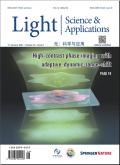Efficient deep-blue LEDs based on colloidal CsPbBr3 nanoplatelets meeting the Rec.2020 standard.
IF 23.4
Q1 OPTICS
引用次数: 0
Abstract
Colloidally quantum-confined CsPbBr3 nanoplatelets (NPLs) exhibit narrow emission linewidths and thickness-tunable photoluminescence, making them ideal candidates for deep-blue perovskite light-emitting diodes (PeLEDs). However, the weak surface coordination of conventional long-chain ligands (e.g., oleylamine and oleic acid) leads to face-to-face stacking of the NPLs, resulting in undesirable emission redshifts in their PeLEDs. Herein, we report an efficient deep-blue PeLED based on colloidal CsPbBr3 NPLs that meet the Rec.2020 color standard, enabled by an acid-assisted ligand passivation strategy. Surface chemical analysis reveals that hydrobromic acid facilitates proton-assisted stripping of the long-chain ligands, followed by the formation of stable Pb-S-P coordination bonds with thio-tributylphosphine, which exhibits a high adsorption energy (Eads = -1.13 eV). This approach significantly improves surface defect passivation, yielding a photoluminescence quantum yield of 96% and a narrow 13 nm full-width-at-half-maximum deep-blue emission. Enhanced exciton recombination and reduced defect state density are evidenced by a prolonged photoluminescence lifetime and slower absorption bleach recovery kinetics. The resulting PeLEDs achieve record-breaking performance among CsPbBr3 NPL-based systems, with a maximum external quantum efficiency of 6.81% at 461 nm, a peak luminance of 143 cd m-2, and the CIE color coordinates (CIE-y = 0.046) that comply with Rec.2020 standards. This work presents an effective strategy for developing efficient and stable deep-blue perovskite emitters, demonstrating significant potential for the commercialization of perovskite nanomaterials in next-generation ultra-high-definition displays.基于胶体CsPbBr3纳米薄片的高效深蓝led符合Rec.2020标准。
胶体量子限制的CsPbBr3纳米薄片(NPLs)具有窄的发射线宽和厚度可调的光致发光特性,使其成为深蓝色钙钛矿发光二极管(PeLEDs)的理想候选材料。然而,传统的长链配体(例如,油胺和油酸)的弱表面配位导致不良物质的正面堆积,导致不良物质的发光红移。在此,我们报道了一种基于胶体CsPbBr3 NPLs的高效深蓝PeLED,该PeLED通过酸辅助配体钝化策略实现,符合Rec.2020颜色标准。表面化学分析表明,氢溴酸有利于质子辅助剥离长链配体,与硫代三丁基膦形成稳定的Pb-S-P配位键,具有较高的吸附能(Eads = -1.13 eV)。这种方法显著改善了表面缺陷钝化,产生了96%的光致发光量子产率和半最大全宽13 nm的窄深蓝发射。增强的激子重组和降低的缺陷态密度证明了延长的光致发光寿命和较慢的吸收漂白剂恢复动力学。由此产生的pled在基于CsPbBr3 npl的系统中实现了破纪录的性能,在461 nm处的最大外部量子效率为6.81%,峰值亮度为143 cd m-2, CIE颜色坐标(CIE-y = 0.046)符合Rec.2020标准。这项工作为开发高效稳定的深蓝色钙钛矿发射器提供了有效的策略,展示了钙钛矿纳米材料在下一代超高清显示器中的商业化潜力。
本文章由计算机程序翻译,如有差异,请以英文原文为准。
求助全文
约1分钟内获得全文
求助全文
来源期刊

Light-Science & Applications
数理科学, 物理学I, 光学, 凝聚态物性 II :电子结构、电学、磁学和光学性质, 无机非金属材料, 无机非金属类光电信息与功能材料, 工程与材料, 信息科学, 光学和光电子学, 光学和光电子材料, 非线性光学与量子光学
自引率
0.00%
发文量
803
审稿时长
2.1 months
 求助内容:
求助内容: 应助结果提醒方式:
应助结果提醒方式:


